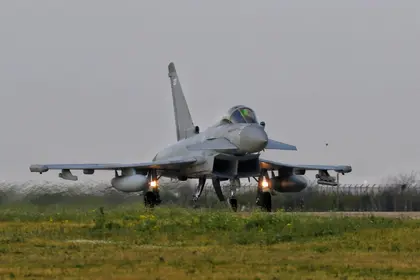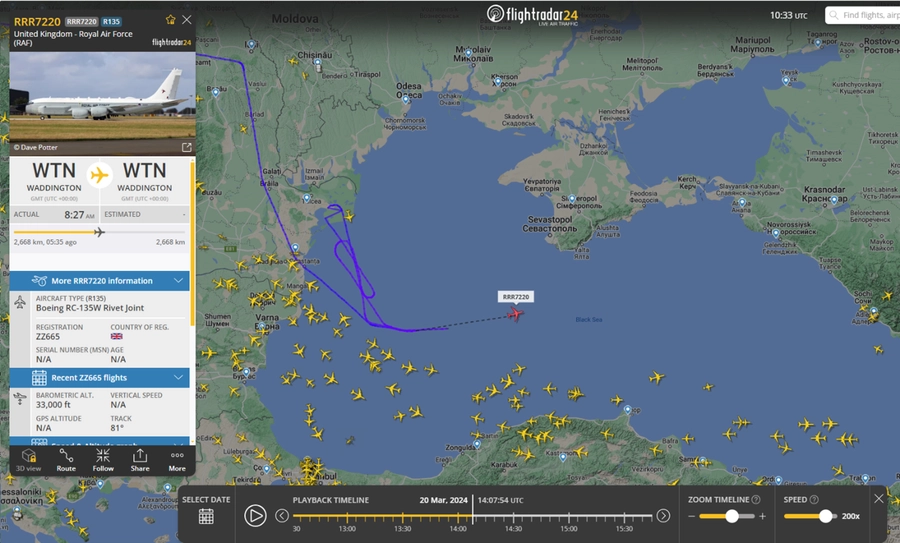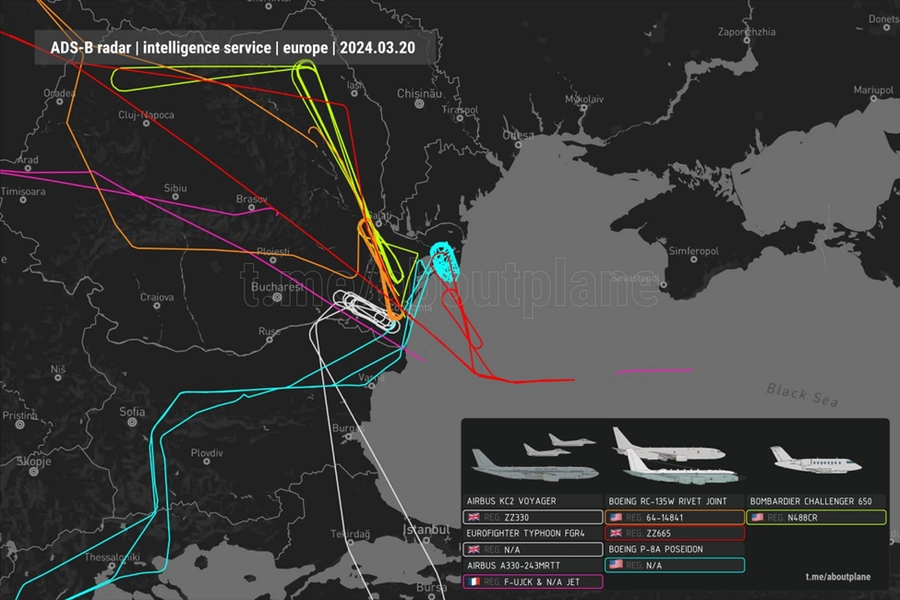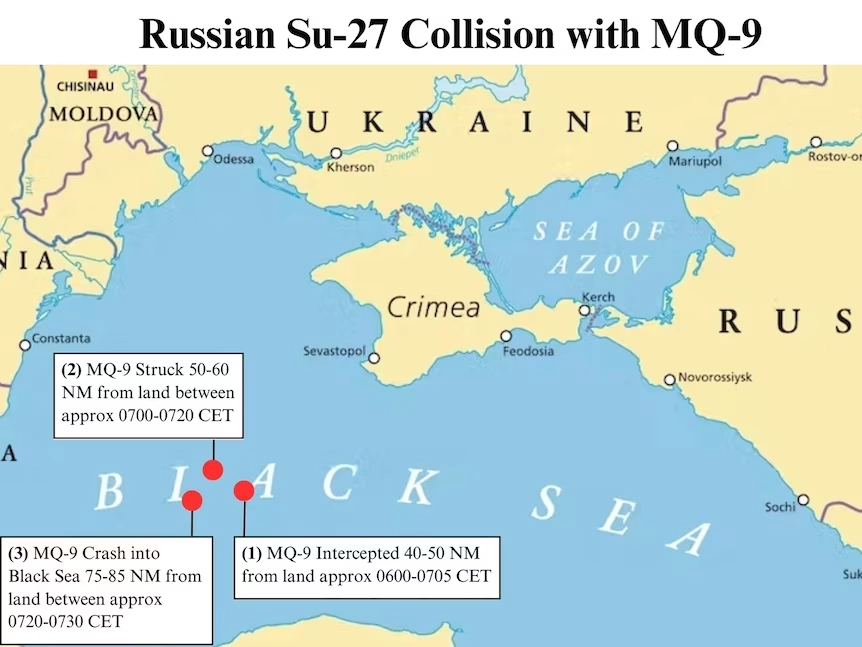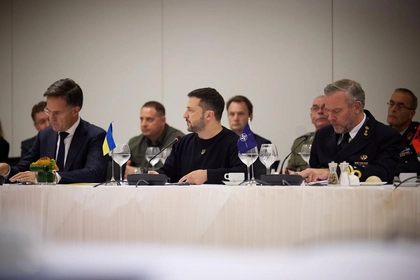The skies over the western Black Sea saw another spike in NATO surveillance aircraft activity on Wednesday, with at least three large intelligence collection aircraft operating opposite Russia-controlled airspace, and British and French fighter jets flying protective cover.
With one exception, all planes in the all-day operation flew elliptical orbiting routes over Romania’s Danube Delta region or the western reaches of the Black Sea nearby.
JOIN US ON TELEGRAM
Follow our coverage of the war on the @Kyivpost_official.
The closest approach to the Russia-controlled Crimea peninsula, by a Royal Air Force RC-135V Rivet Joint electronic reconnaissance aircraft, took place shortly after 2 p.m. local time (12:00 UTC).
Royal Air Force reconnaissance and surveillance jet flies close to Crimea and airspace claimed by Russia, March 20, 2024. At its closest approach the $330 million British spy plane was per the tracker FlightRadar 130-140 km from the Russia-occupied peninsula. Kyiv Post image.
The $330 million British spy plane crammed with state-of-the-art radar detection and radio intercept gear flew to a point some 130 km from land, Kyiv Post review from data published by the Swedish FlightRadar24 and user-run ABSExchange air traffic tracker platforms showed.
Two other heavy, four-engine reconnaissance planes flew tracks over eastern Romania in a probable backstop position. Both were US military – a second RC-135V Rivet Joint call sign Jake 17 and operated by the US Air Force out of Great Britain, and a US Navy P-8A Poseidon maritime patrol plane, no call sign published, flying into the sector from Sicily.
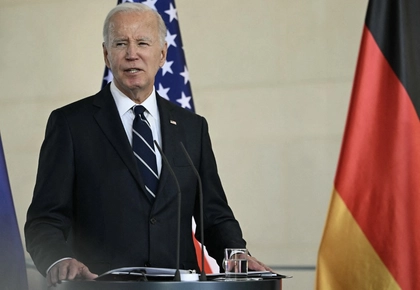
Biden in Berlin Vows no Let-Up on Support for Ukraine
ADS-B air traffic Mar. 20 image of NATO flight tracks over eastern Romania and the western Black Sea. Kyiv Post researchers identified two other NATO aircraft possibly involved in reconnaissance operations during the day.
Local media reported neither interceptions nor engagements with Russian Air Force aircraft. At least one Royal Air Force military air refueling tanker jet was visible in airspace over eastern Romania for most of the day. The track of a second air tanker, also British, was visible for about 15 minutes shortly after 7 p.m. (17:00 UTC).
Kyiv Post was unable to confirm the presence of a second air refueler. Multiple sources reported a privately-owned Bombardier Challenger 650 jet flying along the Romania-Moldova border, in Romanian airspace, along a patrol-like track. One air traffic tracker, Aboutplane, identified the aircraft as a US-operated reconnaissance aircraft.
According to open-source flight data, NATO air battle planners placed at least two fighter jets orbiting in airspace nearby. One was identified as a Royal Air Force FGR4 Eurofighter Typhoon, a supersonic, fourth-generation combat jet. Sources said a second Typhoon might have been present but not visible on radar.
The French Air Force sent at least one fighter jet of its own as part of the combat team, but tracking platforms did not identify the type of aircraft. Some sources said “at least” one French fighter was present.
As a standard rule, NATO fighter aircraft on nearly all missions, including training sorties, fly with at least two aircraft operating as a two-ship formation. When operating together the second and any other wingman aircraft do not have their radar transponder turned on [they don’t “squawk”] while in standard formation, so they would not be “painted” on the flight tracking platforms.
This is done to avoid excessive clutter on air traffic control (ATC) radar screens as a common courtesy and, when not done automatically, will usually be requested by ATC personnel [“Please have number 2 ‘strangle’ their ‘squawk’.”]. The standard procedure is not done for tactical reasons when all aircraft would turn off their transponders visible to ATC.
Taken together, the NATO aircraft count was at least the most numerous spotted over a single day in two weeks, and possibly in months. On March 6 air traffic watchers registered two heavy reconnaissance planes, a long-range drone, an air tanker, and at least one Typhoon fighter jet operating in the area. The large [14.5 m long, 40 m wingspan, 14,000 kg gross weight], high-altitude extended loiter drone, a US Air Force RQ-4B Global Hawk, performed the closest confirmed fly-bys of the Russian mainland, by any NATO aircraft, since Russia’s full-scale invasion of Ukraine.
One day earlier, on March 5, the Kremlin claimed a pair of French Air Force Rafale-S fighter jets escorting an E-3F long-range radar airspace surveillance plane were operating over the Black Sea in airspace too close to Russia-claimed territory, and reportedly Russian air traffic controllers threatened French pilots to change course or be fired on. Paris said the sortie was in international airspace.
Like the British Typhoon, the Rafale-S is rated superior to its Russian Su-27 counterpart thanks to more sophisticated electronics and better-trained pilots.
Russian milbloggers have repeatedly accused NATO of flying spy planes near Crimea and Russia’s Black Sea coast to collect targeting data which is turned over to Ukraine in real-time. Kyiv has confirmed it receives intelligence from allies but does not make details public. Brussels officials say NATO opposes Russia’s invasion of Ukraine but that the Atlantic Alliance is defensive and is not a threat to Russia.
NATO launched “enhanced air policing” operations in airspace to the east of Bulgaria and Romania in 2014 following Russia’s invasion and annexation of Crimea, a part of Ukrainian territory under international law. The Kremlin treats Crimea as Russian territory and airspace around it as Russian. According to NATO official statements, the air policing initiative’s primary mission is protecting NATO airspace and ensuring free movement of air traffic and shipping in the Black Sea.
Since Russia’s February 2022 full-scale invasion of Ukraine, NATO members Great Britain, France, Turkey, Canada, Italy, and Germany have sent combat aircraft, and pilots/aircrew and ground crew, for air policing operations to the east of Romania and Bulgaria. Reconnaissance aircraft, air refueling tankers, and cargo planes typically fly in from home countries to support the fighter patrols.
Approaches by NATO aircraft to airspace near Crimea sometimes trigger Russian Air Force intercepts, and from time to time, near-shooting incidents between the Kremlin and the Atlantic Alliance.
The closest call according to Whitehall statements took place in September 2022 when a Russian pilot aboard a Su-27 launched from Crimea misunderstood instructions from ground control and attempted to fire a missile against a British Rivet Joint reconnaissance jet flying over international waters. The missile failed to launch and the Royal Air Force plane returned to base unharmed. Russian Defense Minister Sergei Shoigu later said it was an accident.
On March 14, 2023, a Russian Su-27 flying out of Crimea dumped aviation fuel on and then rammed a US Air Force MQ-9 Reaper drone flying over international waters off of Crimea, knocking the US robot plane out of the sky. The Kremlin later accused Washington of operating a drone near “Russian” airspace with its transponder turned off.
Location of US Air Force MQ-9 Reaper drone shot down over the Black Sea on March 13, 2023. The reconnaissance aircraft was well out over international waters, but according to the Kremlin and international flight tracking organizations operating with its transponder turned off. US Air Force hand-out.
Washington vowed the US military would continue to exercise the right of free passage through international airspace. Since then, the US Air Force has operated the high-flying Global Hawk drone, with transponder turned on, for reconnaissance flights near Crimea and Russia’s Black Sea coast.
NATO fighter escort of reconnaissance flights over eastern Romania and the western Black Sea became common practice in mid-2023.
You can also highlight the text and press Ctrl + Enter


